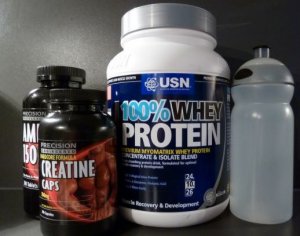Muscle Hypertrophy: What it is and How to Achieve it

It is the number one objective for many people signing up for a gym membership. Building muscle for a sleek and toned physique is well worth the hours of exercise and sacrifice. However, not everyone understands the underlying principle of muscle hypertrophy, the term used to describe an increase in muscle mass.
How does it happen? How can you achieve it? Will supplements help?
In this article, we will take a detailed look at the basics of muscle hypertrophy, something that a lot of people talk about, but few people understand.

There are two ways of achieving muscle hypertrophy. In each case, one leads to the other.
Myofibrillar hypertrophy
This refers to an increase in the volume of your muscle fibers, or on rare occasions, the amount of muscle fibers. Working with weights that the body is not accustomed to, can produce tears in these fibers. The body interprets these as injuries, and upon regenerating them, increases their volume so as to prevent the injury from reoccurring.
This type of hypertrophy makes the muscle grow and become stronger. It can be achieved by doing a small number of repetitions (three to six), but using a considerable amount of weight.
As progress is made in the training of each muscle group, the weight used in the exercise should vary. The maximum should be 80 percent of the weight that can be lifted in a single repetition.
Sarcoplasmic hypertrophy
Sarcoplasm is a viscous substance found around the muscles. When you perform a large number of repetitions (8-12) with a moderate amount of weight, the sarcoplasm’s ability to deposit energy improves.
Specifically, the sarcoplasm contains adenosine triphosphate (ATP) and glycogen. The process is the same as in myofibrillar hypertrophy. When the muscle runs out of energy, the recovering organ creates greater deposits in order to combat the exhaustion.
The difference with this type of training is that the latter does not increase strength. Rather, it relates to muscle fatigue. It should include between 10 and 15 repetitions with 75 percent of the maximum weight. You should rest for about one minute between sets.
Using steroids for muscle hypertrophy
While they are not a natural method for achieving hypertrophy, steroids can help make the goal a reality. Anabolic steroids create a hormonal stimulus to make muscles grow.
Those used most frequently are testosterone and its derivatives, dihydrotestosterone (and related products), and nandrolone (and similar substances).
However, their use in the sports world, an infraction known as “doping,” is met with punishment. Furthermore, steroids can produce severe side effects, these include:
- If consumed during adolescence, they may interfere with genital development.
- Masculinity in women, due to the increase in testosterone.
- Diminished reproductive ability in both genders.
- Cardiac problems.
- Emotional disturbances and mood swings.
- Water retention.
Some advice for achieving hypertrophy
Lift weights and progressively increase the amount
For a muscle to increase in mass through exercise, you need to subject it to something called metabolic stress. This is how you achieve muscle hypertrophy.
As such, you need to use an appropriate amount of weight while exercising. This way, the workout will demand sufficient exertion from the muscles. Meanwhile, if you do not gradually increase the amount of weight, the muscles will adapt and they will not grow.
A small number of reps and rest
Depending on the kind of hypertrophy you want, the amount of repetitions and sets will vary. Nevertheless, you should never exceed 12-15 repetitions, or three to four sets. Any “extra” sets will offer no additional benefit.
By the same token, you need to rest for 60 to 90 seconds between sets, so that the energy in your muscles can replenish. Generally, the muscles become exhausted after 12 seconds of exertion.
Using supplements

In addition to maintaining a high-protein diet, those seeking to achieve muscle growth usually use supplements to aid development. The most popular are those containing creatine and whey protein. When it comes to supplements, seek out recommendations from a nutrition professional in order to avoid any imbalance in your diet.
Choose weight according to the number of repetitions
Experts in muscle hypertrophy recommend adjusting the amount of weight used, to the number of repetitions you are doing, not vice versa. This is due to the fact that it will promote the kind of gradual improvement that we mentioned earlier, preventing the muscle from adapting to the weight.
Finally, this kind of training should be accompanied by a healthy, balanced diet that is high in carbohydrates and proteins. These two nutrients give you the energy and “material” you need to regenerate the torn tissues.
Of course, visiting a nutrition specialist is an excellent idea. Often, you will need to reduce body fat in order to achieve muscle definition. An expert can tell you which area of your diet requires adjustment, in order to obtain the results you want.
It is the number one objective for many people signing up for a gym membership. Building muscle for a sleek and toned physique is well worth the hours of exercise and sacrifice. However, not everyone understands the underlying principle of muscle hypertrophy, the term used to describe an increase in muscle mass.
How does it happen? How can you achieve it? Will supplements help?
In this article, we will take a detailed look at the basics of muscle hypertrophy, something that a lot of people talk about, but few people understand.

There are two ways of achieving muscle hypertrophy. In each case, one leads to the other.
Myofibrillar hypertrophy
This refers to an increase in the volume of your muscle fibers, or on rare occasions, the amount of muscle fibers. Working with weights that the body is not accustomed to, can produce tears in these fibers. The body interprets these as injuries, and upon regenerating them, increases their volume so as to prevent the injury from reoccurring.
This type of hypertrophy makes the muscle grow and become stronger. It can be achieved by doing a small number of repetitions (three to six), but using a considerable amount of weight.
As progress is made in the training of each muscle group, the weight used in the exercise should vary. The maximum should be 80 percent of the weight that can be lifted in a single repetition.
Sarcoplasmic hypertrophy
Sarcoplasm is a viscous substance found around the muscles. When you perform a large number of repetitions (8-12) with a moderate amount of weight, the sarcoplasm’s ability to deposit energy improves.
Specifically, the sarcoplasm contains adenosine triphosphate (ATP) and glycogen. The process is the same as in myofibrillar hypertrophy. When the muscle runs out of energy, the recovering organ creates greater deposits in order to combat the exhaustion.
The difference with this type of training is that the latter does not increase strength. Rather, it relates to muscle fatigue. It should include between 10 and 15 repetitions with 75 percent of the maximum weight. You should rest for about one minute between sets.
Using steroids for muscle hypertrophy
While they are not a natural method for achieving hypertrophy, steroids can help make the goal a reality. Anabolic steroids create a hormonal stimulus to make muscles grow.
Those used most frequently are testosterone and its derivatives, dihydrotestosterone (and related products), and nandrolone (and similar substances).
However, their use in the sports world, an infraction known as “doping,” is met with punishment. Furthermore, steroids can produce severe side effects, these include:
- If consumed during adolescence, they may interfere with genital development.
- Masculinity in women, due to the increase in testosterone.
- Diminished reproductive ability in both genders.
- Cardiac problems.
- Emotional disturbances and mood swings.
- Water retention.
Some advice for achieving hypertrophy
Lift weights and progressively increase the amount
For a muscle to increase in mass through exercise, you need to subject it to something called metabolic stress. This is how you achieve muscle hypertrophy.
As such, you need to use an appropriate amount of weight while exercising. This way, the workout will demand sufficient exertion from the muscles. Meanwhile, if you do not gradually increase the amount of weight, the muscles will adapt and they will not grow.
A small number of reps and rest
Depending on the kind of hypertrophy you want, the amount of repetitions and sets will vary. Nevertheless, you should never exceed 12-15 repetitions, or three to four sets. Any “extra” sets will offer no additional benefit.
By the same token, you need to rest for 60 to 90 seconds between sets, so that the energy in your muscles can replenish. Generally, the muscles become exhausted after 12 seconds of exertion.
Using supplements

In addition to maintaining a high-protein diet, those seeking to achieve muscle growth usually use supplements to aid development. The most popular are those containing creatine and whey protein. When it comes to supplements, seek out recommendations from a nutrition professional in order to avoid any imbalance in your diet.
Choose weight according to the number of repetitions
Experts in muscle hypertrophy recommend adjusting the amount of weight used, to the number of repetitions you are doing, not vice versa. This is due to the fact that it will promote the kind of gradual improvement that we mentioned earlier, preventing the muscle from adapting to the weight.
Finally, this kind of training should be accompanied by a healthy, balanced diet that is high in carbohydrates and proteins. These two nutrients give you the energy and “material” you need to regenerate the torn tissues.
Of course, visiting a nutrition specialist is an excellent idea. Often, you will need to reduce body fat in order to achieve muscle definition. An expert can tell you which area of your diet requires adjustment, in order to obtain the results you want.
This text is provided for informational purposes only and does not replace consultation with a professional. If in doubt, consult your specialist.








